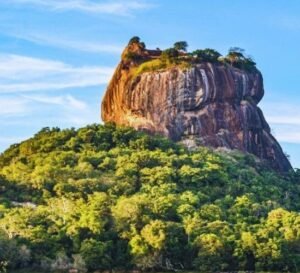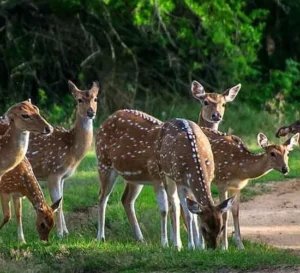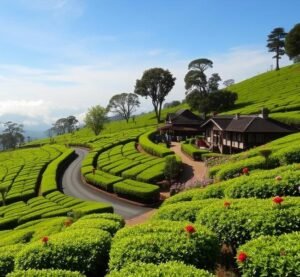Sri Lanka
UTC+5:30 (Sri Lanka Standard Time)
No daylight saving time observed
Sri Lankan Rupee (LKR)
Symbol: Rs or රු
Major credit cards accepted in hotels and larger establishments
February 4, 1948 (from the United Kingdom)
Previously known as Ceylon until 1972
Rich history dating back over 2,500 years
Visa-Free Countries
Visa on Arrival Countries
E-Visa Countries
Visa Required Countries
Culture
Sri Lanka's culture is a vibrant tapestry woven from diverse religious and ethnic influences spanning over 2,500 years. Known as the "Pearl of the Indian Ocean," this island nation has been shaped by Buddhism, Hinduism, colonial influences, and its strategic position along ancient trade routes.
Key elements of Sri Lankan culture include:
- Religious diversity: Buddhism is the predominant religion (70% of the population), with significant Hindu, Muslim, and Christian communities. Religion plays a central role in daily life, with numerous temples, kovils (Hindu temples), mosques, and churches scattered across the island. The Temple of the Sacred Tooth Relic in Kandy, believed to house a tooth of the Buddha, is one of Buddhism's most important shrines.
- Arts and crafts: Traditional Sri Lankan arts include intricate mask carving, batik textile production, woodcarving, brass work, and pottery. Particularly famous are the vividly painted wooden masks from the southern coastal region, used in traditional dance performances and healing rituals. The ancient art of lacework from Galle and Batticaloa reflects Portuguese colonial influences.
- Dance and music: Sri Lanka has several distinct traditional dance forms, including the energetic Kandyan dance (originating from hill country rituals), the more graceful low-country dance, and the Sabaragamuwa dance. Each features elaborate costumes and is typically accompanied by specific percussion instruments like the geta beraya (drum).
- Architecture: Ancient Sri Lankan architecture is exemplified by impressive dagobas (stupas), ancient cities like Anuradhapura and Polonnaruwa, and the remarkable rock fortress of Sigiriya. Colonial influences are evident in the Dutch and British structures in Galle and Colombo, while vernacular architecture features distinctive rooflines adapted to the tropical climate.
- Festivals: Sri Lanka celebrates numerous colorful festivals throughout the year. The most spectacular is Esala Perahera in Kandy, a 10-day procession featuring elaborately decorated elephants, traditional dancers, and drummers. Other important celebrations include Thai Pongal (Tamil harvest festival), Vesak (Buddha's birth, enlightenment, and death), and Sinhala and Tamil New Year in April.
Sri Lankan cuisine reflects the island's history, geography, and cultural influences:
- Rice and curry: The staple meal consists of rice served with multiple curry dishes, sambols (spicy condiments), pickles, and chutneys. A traditional Sri Lankan rice and curry meal might include 5-10 different preparations.
- Distinctive flavors: Sri Lankan cuisine is characterized by liberal use of coconut milk, spices (especially cinnamon, cardamom, and cloves, which grow abundantly on the island), and chili heat. Curry leaves, pandan leaves, and goraka (a souring agent) create distinctive flavor profiles.
- Notable dishes: Hoppers (bowl-shaped pancakes made from fermented rice flour batter), string hoppers (steamed rice noodle cakes), kottu roti (chopped flatbread stir-fried with spices and meat or vegetables), and lamprais (rice and curries baked in banana leaf, reflecting Dutch influences).
- Seafood: Being an island nation, Sri Lanka has a rich tradition of seafood dishes, particularly along the coast. Fish ambul thiyal (sour fish curry) and crab curry are specialties.
- Tea culture: Sri Lanka is one of the world's leading tea producers. Ceylon tea is renowned globally, and the tea plantations in the central highlands form an important part of both the economy and cultural landscape.
Family and community ties remain strong in Sri Lankan society. Traditional values emphasize respect for elders, hospitality toward guests, and community cooperation. These values coexist with modernization and global influences, particularly in urban areas like Colombo, creating a dynamic blend of traditional heritage and contemporary life.
Tourism & Best Sites to Visit
Sri Lanka offers an incredible diversity of experiences within a compact area, from ancient UNESCO World Heritage sites to pristine beaches, lush tea plantations, and abundant wildlife. The island nation's reputation as a tourism destination has grown significantly in recent years, attracting travelers seeking culture, adventure, wellness, and natural beauty.
Here are some of Sri Lanka's most remarkable destinations:





Sigiriya Rock Fortress: This UNESCO World Heritage site features a dramatic 200-meter rock column topped with the ruins of an ancient palace complex built in the 5th century CE. Visitors climb stairs past ancient frescoes and the famous Lion Gate to reach the summit, where they're rewarded with spectacular views. The surrounding gardens, among the oldest landscaped gardens in the world, showcase sophisticated hydraulic engineering.
Galle Fort: Built by the Portuguese and fortified by the Dutch, this UNESCO-protected colonial walled city on the southwest coast blends European architecture with South Asian traditions. Its narrow streets are lined with boutique shops, cafes, and historic buildings. Walking the ramparts at sunset, with views of the Indian Ocean on one side and the old town on the other, is a quintessential Sri Lankan experience.
Kandy: The cultural capital of Sri Lanka, Kandy was the last independent kingdom before British colonial rule. The sacred Temple of the Tooth Relic, housing a tooth of the Buddha, makes it an important pilgrimage site. Other attractions include the picturesque Kandy Lake, the Royal Botanical Gardens at Peradeniya, and traditional cultural performances. Kandy also serves as the gateway to the central highlands.
Yala National Park: The most visited wildlife reserve in Sri Lanka, Yala boasts the highest density of leopards in the world, along with elephants, sloth bears, crocodiles, and hundreds of bird species. The diverse landscape includes monsoon forests, grasslands, lagoons, and coastal dunes. Besides wildlife, the park contains the ruins of ancient civilizations, adding a cultural dimension to the natural experience.
Nuwara Eliya: Known as "Little England," this colonial hill station sits at 1,900 meters elevation in the tea country. Its cool climate, Tudor-style buildings, and manicured gardens reflect British influences. Visitors can tour working tea plantations, hike in the surrounding mountains, or enjoy boating on Gregory Lake. The town is also known for its beautiful flowers and annual horse races.
Other remarkable destinations include the ancient cities of Anuradhapura and Polonnaruwa with their massive dagobas (stupas) and Buddha statues; the golden beaches of Mirissa and Unawatuna; Ella, with its scenic railway journey and hiking trails; Dambulla's cave temples filled with Buddhist artwork; and Adam's Peak, a sacred mountain climbed by pilgrims of multiple faiths.
Transportation
Sri Lanka offers diverse transportation options for navigating the compact island nation. While distances are relatively short, journey times can be longer than expected due to winding roads and varying infrastructure quality. The transport experience is part of the Sri Lankan adventure, from scenic train journeys through tea plantations to colorful local buses and tuk-tuks.
- Railways: Sri Lanka's railway network, dating from British colonial times, connects major cities and scenic regions. The Kandy to Ella train journey is considered one of the most beautiful in the world, passing through misty mountains and verdant tea plantations. Other popular routes include the coastal line from Colombo to Galle and the northern line to Jaffna. Trains are affordable but can be crowded; reserved seats in observation cars or first class are recommended for tourists, especially on scenic routes.
- Buses: Public buses reach virtually every corner of the island and are extremely affordable. They range from modern air-conditioned intercity express services to basic local buses. While they offer an authentic local experience, buses can be crowded and driving styles sometimes adventurous. Private bus companies typically provide more comfortable services than government-run buses for longer journeys.
- Tuk-tuks (Three-wheelers): These ubiquitous three-wheeled taxis are ideal for short distances within towns and cities. Always negotiate the fare before starting your journey or look for metered tuk-tuks (common in Colombo). Apps like PickMe allow you to book tuk-tuks with fixed prices in major cities.
- Taxis and car hire: Taxis with drivers can be arranged through hotels or agencies for day trips or longer journeys. This offers flexibility and comfort, though at higher cost than public transportation. Self-drive car rental is less common but becoming more available. Driving is on the left side of the road (British influence).
- Domestic flights: Cinnamon Air operates scheduled seaplane and small aircraft services connecting Colombo with destinations like Trincomalee, Batticaloa, and Koggala. These save considerable time compared to road travel and offer spectacular aerial views, though they are more expensive than ground transportation.
Transportation tips: Consider these factors when planning travel in Sri Lanka:
- Book train tickets for popular scenic routes well in advance, as they sell out quickly, especially in high season
- For multiple destinations, consider hiring a driver for part or all of your trip - this offers convenience and local insights
- Buses are most frequent in the morning and early afternoon; services reduce significantly in the evening
- Traffic in Colombo and major towns can be congested during rush hours (8-9 AM and 5-7 PM)
- Tuk-tuks are convenient for short trips but not ideal for long distances due to open-air design and exposure to weather and pollution
The Cultural Triangle and beaches: The most popular tourist circuit covers Colombo, the Cultural Triangle (Anuradhapura, Polonnaruwa, Sigiriya, Dambulla), Kandy, the hill country (Nuwara Eliya, Ella), and southern beaches. This route is well-served by public transportation, though having a private driver offers more flexibility to visit off-the-beaten-path sites.
Safety considerations: Road safety standards may differ from Western countries. If using public transportation, secure your belongings, especially in crowded situations. For taxis and drivers, using established companies or arrangements through hotels generally ensures reliable service.
Airports
Sri Lanka has several airports serving international and domestic flights, providing good connectivity both internationally and within the island:
- Bandaranaike International Airport (CMB): Located in Katunayake, approximately 30 km north of Colombo, this is Sri Lanka's main international gateway. The airport handles over 10 million passengers annually and offers connections to major destinations in Asia, the Middle East, Europe, and Australia. Airlines serving Bandaranaike include Sri Lankan Airlines (the national carrier), Emirates, Qatar Airways, Singapore Airlines, and numerous others. The terminal features duty-free shopping, restaurants, lounges, and currency exchange services.
- Mattala Rajapaksa International Airport (HRI): Situated near Hambantota in the southern part of the island, this is Sri Lanka's second international airport. Currently handling a limited number of flights, it primarily serves regional destinations and charter flights. The airport is close to Yala National Park and southern beach destinations.
- Jaffna International Airport (JAF): Recently upgraded to handle international flights, particularly from South India, this airport serves the northern part of Sri Lanka. It facilitates easier access to the cultural sites of the northern peninsula, which was historically difficult to reach.
- Ratmalana Airport (RML): Located closer to Colombo city than Bandaranaike, Ratmalana primarily handles domestic flights and some regional international services. It was Sri Lanka's first international airport before the opening of Bandaranaike.
- Batticaloa Airport, Trincomalee Airport, and Koggala Airport: These domestic airports serve eastern and southern regions and are primarily used for domestic connections and charter flights, including scenic seaplane services operated by Cinnamon Air.
Airport Transportation: Options for reaching your destination from the main Bandaranaike International Airport include:
- Airport Expressway: The modern highway connects the airport to Colombo in approximately 30 minutes (depending on traffic), significantly faster than the previous route.
- Airport Taxis: Available at designated counters with fixed rates to various destinations. Pre-booking is possible but not necessary.
- Bus services: Public and private buses connect the airport to Colombo's Central Bus Station and other destinations. These are significantly cheaper than taxis but less convenient with luggage.
- Hotel transfers: Many hotels offer airport pickup services, which can be convenient for first-time visitors.
- Ride-hailing services: Apps like PickMe operate from the airport with designated pickup points.
Important notes: Arrive at least 3 hours before international flights from Bandaranaike Airport, as security procedures can be thorough. The airport has implemented various COVID-19 safety measures, including temperature screening and sanitization procedures. When planning your itinerary, consider that the airport is closer to Negombo than to Colombo, making Negombo a convenient first or last stop, especially for late arrivals or early departures.
Visa & Travel Information
Most foreign nationals require an Electronic Travel Authorization (ETA) before visiting Sri Lanka. This system has streamlined the visa process, making it more convenient for tourists and business travelers.
Visa Types and Requirements
The following table outlines visa options for different nationalities:
| Nationality | Entry Option | Maximum Stay |
|---|---|---|
| Most Countries (Including USA, UK, EU, Australia, Canada, etc.) | ETA Required | 30 days (extendable up to 6 months) |
| Singapore, Maldives, Seychelles | Visa-Free | 30 days |
| SAARC Countries (India, Pakistan, Bangladesh, etc.) | ETA Required | 30 days (different fee structure) |
| All Nationalities (longer stays) | Entry Visa/Residence Visa | Varies by visa type |
ETA Application Process: The Electronic Travel Authorization can be obtained through the official Sri Lanka ETA website. The process typically involves:
- Completing an online application form with passport and travel details
- Paying the processing fee (varies by nationality and visa type)
- Receiving the ETA approval via email, usually within 24 hours
For those unable to apply online before travel, ETA facilities are available at Bandaranaike International Airport, though fees are higher for on-arrival applications. An ETA allows double entry within 30 days and can be extended up to 6 months through the Department of Immigration and Emigration in Colombo.
- Asia
- Singapore
- Japan
- South Korea
- Africa
- Seychelles
- Mauritius
- South Africa
- Contact:
- Address: Eighth Avenue Place, East Tower, 525 8 Avenue SW Suite 3200 Calgary, Alberta T2P 1G.
- Email: Info@theazmip.com
- Number: +12812363495
Travel the World Without the Burden of Visa Applications, as TheAzmip.com Connects You to the Best Visa-Free Destinations.
- North America
- United States
- Canada
- Mexico
- Oceania
- Australia
- New Zealand
- Samoa

